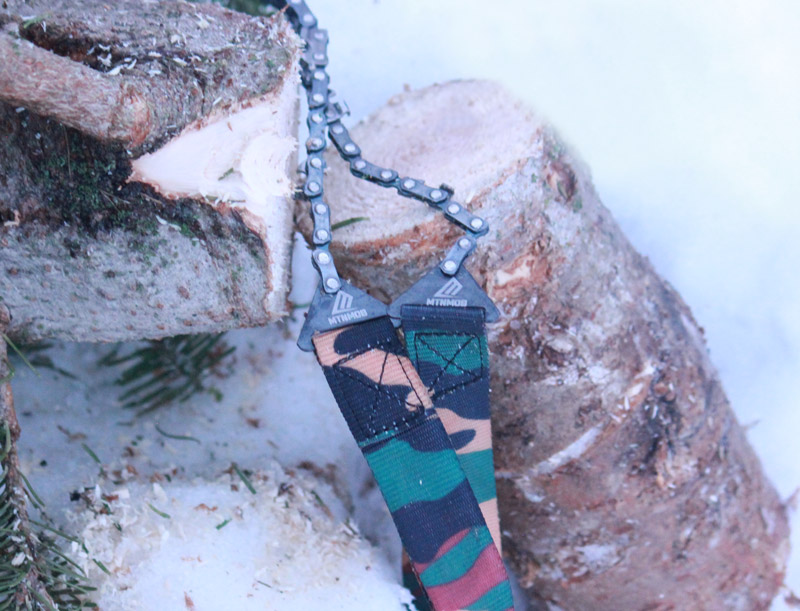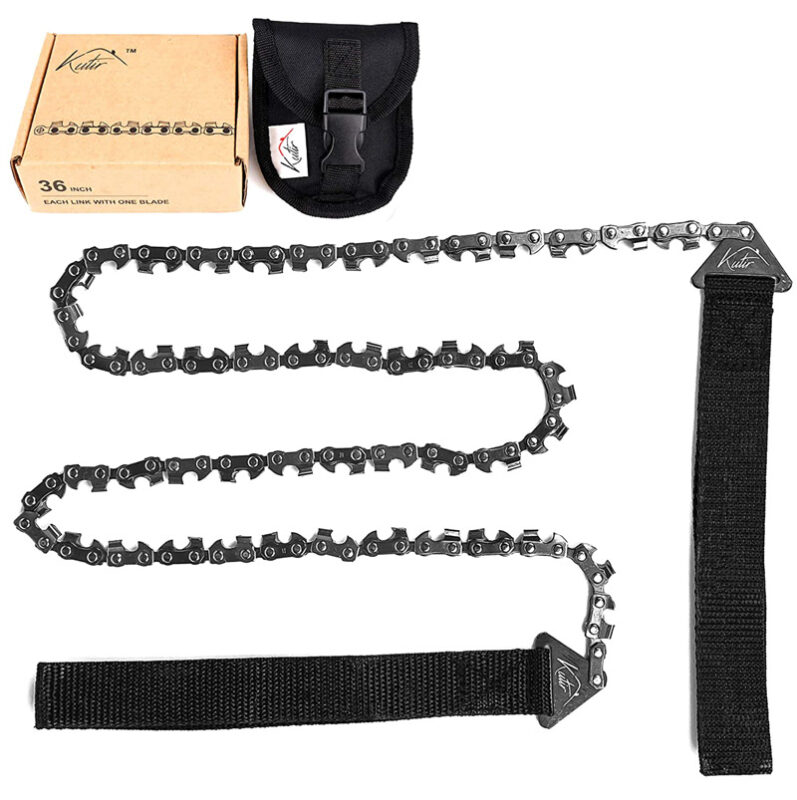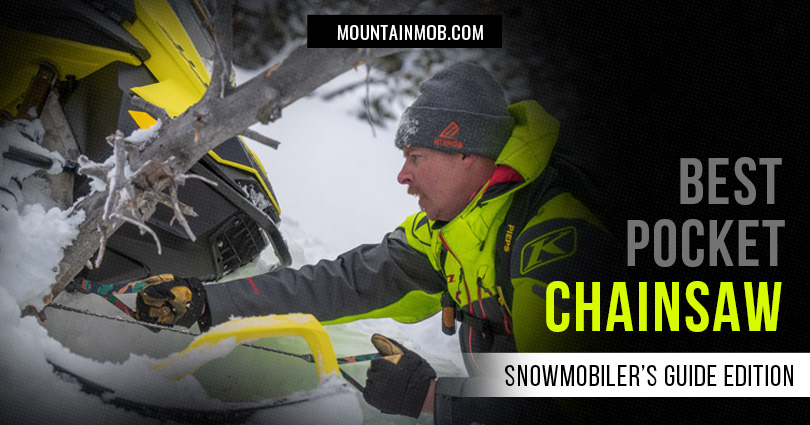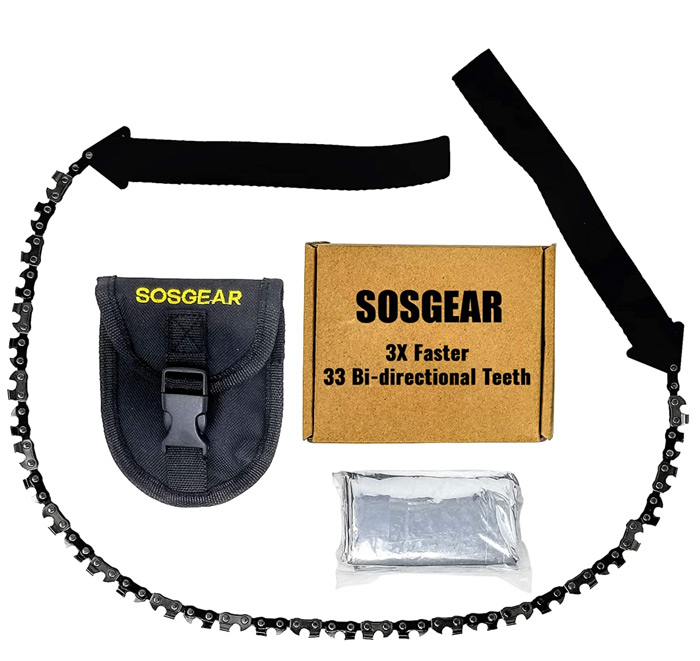Camping, Snowmobiling
Best Pocket Chainsaw
We all know that a big power chainsaw is the go-to for getting the job done when we want a tree to two cut down, cleared, made into firewood. Whether for the backyard, a camping trip or a deep backcountry adventure, you should strongly consider having a reliable and the best pocket chainsaw on hand. Often overlooked, and underrated, this handy piece of equipment add a whole different dimension to your wood cutting adventures; whether you’re cutting trees or branches for firewood, making a shelter, or clearing your setup and shooting lanes ahead of deer season.
As opposed to hatchets or handsaws, the pocket chainsaw packs up into a small pouch for easy storage and transportation, but also is designed to wrap around the branch whilst cutting to make for a quick and uniform cut. Often coming with straps attached to either end, this allows the cutter to hold a firm two-handed grip, which also affords the luxury of leaning with a little body weight to give some extra strength to the cut.
— SCROLL DOWN TOWARDS THE BOTTOM TO SEE OUR POCKET CHAINSAW COMPARISONS —
Pocket Chainsaw vs Other Saws
There’s now a decent variety of wood cutting tools available now on the market. Some expensive, heavy and highly effective. Some small, light and takes putting those arm muscles to good use.
Power Chainsaw
Exactly what most people think of when you hear the word “chainsaw”. The aggressive power tool capable of taking down any tree in no time. These saws are very effective for high intensity cutting.
Pros:
- Most capable at sawing larger and stronger wood.
- Powered chain removes most of the manual cutting work.
- Cuts wood in a very fast, efficient manner.
Cons:
- Usually makes a lot of noise.
- Heavy and large in size (portability is limited).
Folding Saw
Probably the pocket chainsaw’s closest competitor when considering practicality, weight and size. The folding saw is a smaller, foldable, packable version of a standard hand saw.
Pros:
- Sawing motion with the handsaw is often more familiar to the user.
- Can be used with only one hand.
- Easily packable – either at home, in the car, or in a backpack.
Cons:
- Less durable than the blades of a pocket chainsaw.
- Less effective on mid-large size branches.
- More tiring, single armed motion than the pocket chainsaw.
- Slower than the pocket chainsaw as it only cuts from one side.
Pocket Chainsaw
Just like the folding saw is the lightweight, portable version of the traditional hand saw, the pocket chainsaw is the lightweight, portable version of the powered chainsaw.
Pros:
- Greater durability and requires less sharpness upkeep than a folding saw.
- Able to cut trees and logs of a wide diameter than the folding saw.
- Easily packable – either at home, in the car, or in a backpack.
- Sawing motion dispersed across two arms, and often has a more manually efficient motion than the folding saw.
- Cuts faster than the folding saw as it wraps around the branch whilst cutting.
Cons:
- Sawing motion with the pocket chainsaw is less familiar to the user.
- Requires two hands to be able to saw.
- Requires more manual work than a power saw.
- Less capable than a power saw for large cutting jobs.
Side Note: Wire Saws
You may have seen small wire versions of a pocket chainsaw included in pre-prepared off-the-shelf survival kits, referred to as a “wire saw”. Many of these lack the strength, length or design to really be effective and reliable in the field. So, let’s look at what you need to know to find the best pocket chainsaw for your needs.
When to Use a Pocket Chainsaw
A pocket chainsaw can come in handy in a multitude of situations, in different places, at different times; when you are prepared for it, or when you least expect it. Here are some of the examples of places and times when you may benefit from having one on hand:
- Home: Don’t want to wake up the neighbours for the sake of clipping a few branches along the fence-line? Don’t want to spend a few hundred dollars on a power saw for the occasional once-off jobs? Rather just throw a small portable saw pouch into your tool box rather than storing a large powertool? The pocket chainsaw can attend to branch work and tree pruning around the home without the noise, expense and storage of a motorized saw, getting it done in an easy and subtle fashion.
- Vehicle: This is especially relevant for people who live or travel throughout rural areas, or occasionally venture down the odd dirt road. Campers, hunters, anglers, hikers, mountain bikers… I’m looking at you. Having a pocket chainsaw not only just on the basis of a vehicle survival kit item for breaking down in the winter, but can also be valuable if surprised by the inconvenience of a downed tree on your way. This isn’t just limited to car travel, but probably even more frequently while out and about on an ATV or snowmobile.
- Camp: Whether going on a casual weekend camp or venturing deep into the backcountry, having a pocket chainsaw can be a life saver. As mentioned, many survival kits offer a basic wire saw, which is unlikely to get the big and important jobs done when you really need it. Replacing that with a proper pocket chainsaw will ensure you are better equipped to attain firewood and build shelters. They also come in very handy for clearing spaces for camp setup or hunting blinds and stands.
Pocket Chainsaw Detail Considerations
Okay, it’s time to get a pocket chainsaw… but which one to choose? When trying to determine which one is the best pocket chainsaw, there are a few key aspects to consider:
Chain Length
The length of the blade chain is an important factor to understand when it comes to your intended purpose for the pocket chainsaw. The various lengths all off their own pros and cons, depending on use.
- Under 22 inches: Found most regularly in small survival kits, this pocket chainsaw wire/blade length is best suited to small diameter pieces of wood, of which does not require any additional reach or length (such as removal of overhead boughs).
- 23 to 36 inches: A more common and universal length range, offering flexibility in its usage. With a mid-length saw you have the opportunity to tackle slightly larger diameter branches and also offers the ability to tackle slightly harder to reach spots. Not difficult to maintain tension on the chain.
- Over 37 inches: Handy for clearing higher boughs or attempting to cut through thicker stumps. Sometimes a little less practical for smaller cuts due to excess chain length resulting in additional distance required to create the required tension, and may snag or buckle if tension on the chain is not sustained.
Weight
The weight of a pocket chainsaw is mostly determined by the blade material and length. Finding the right balance between weight and structural integrity becomes a greater factor when venturing deep into the backcountry, where weight and size may need to be restricted to some capacity. Here we look at weights and their considerations:
- Under 3 ounces: Commonly found with smaller wire-style pocket saws. In most cases in the durability and strength of the saw is compromised in order to make additional savings on weight and size.
- 3 to 5 ounces: In this weight range you tend to find pocket chainsaws with a chain length of approximately 24”, which make an effort to provide a balance between weight, practicality and material durability.
- Over 6 ounces: These greater weights are most often the result of a longer chain length, or additional chain material. Can be great for uses that less often require aspects of pack-ability, but can be a handy addition for at home or when you intend on attempting bigger tasks.
Handle Design
- Wrist Strap Design: The most common and reliable pocket chainsaw handle design is the wrist strap. This allows the cutter to either go standard hand grip, or to slide their wrists through and hold above the strap connection point to allow for a stronger grip with a balance of pressure through the palm, fingers and wrist.
- Paracord Design: This design comes with both pros and cons. The paracord (parachute cord) aspect itself creates extra flexible and practicality in when trying to adapt in survival-style situations as it can be used for many purposes. However, the grip offered is generally not as comfortable and consistent than the wrist strap design. What is lost in a reliable grip can be balanced out by the ability to create additional length to the saw to be able to throw over and attempt cuts on out-of-reach branches.
- Grip Handle: These are less common but still found time to time, either as the primary handle or as an attachment in a larger pocket chainsaw kit. These are comfortable in the hand, but requires a strong, consistent clenched fist hold. Unless you’re already well known as “The Gripmaster” these are better for smaller and infrequent jobs.
- Finger Handle: The finger handle type is mostly found on the smaller wire pocket saws, often found in cheaper-end survival kits. These are not very comfortable to use as all the force of the hold is put onto the skin of your fingers, not too dissimilar to the hand-cutting feeling of carrying too many heavy grocery bags.
Blade Material
The majority of better quality pocket chainsaws are made from high-carbon heat-treated steel. The heat-treating process on steel (regularly seen on industrial items) helps to create additional strength, ductility (a material’s ability to handle being forced into shape without failing under stress), toughness and corrosion resistance. Having a high carbon content allows the steel to retain sharpness for longer. You may find other pocket chainsaws or wire saws made from stainless steel, but are likely to be less durable than their high-carbon counterpart, however stainless steel is more resistant to corrosion.
Teeth Count
Pocket chainsaws can also vary in tooth count and configuration. Most chains come single-sided when it comes to cutting teeth placement, but dual-sided pocket chainsaws are also available. Another key aspect is cutting tooth spacing, which affects the total number of cutting teeth the saw has. You can be forgiven for thinking “the more teeth, the better”, but this is not always the case. Here we will look at the pros and cons of the different saw tooth configurations:
- Filled (more teeth): Having additional teeth allows for the chainsaw to distribute the wear and workload across more area of the chain. Once the momentum of the cut is going, this configuration can make for an easier cut as there are more teeth working to saw through the wood.
- Spaced (less teeth): By adding spacing between the teeth, the saw becomes easier to get the initial cuts started, as there is less resistance between the chain and the wood. By having a percentage of the chain not on cutting duty, it allows for the chain to slide and cut at the same time which usually makes the cutting process quicker and a little more approachable.
- Dual-sided: With a dual-sided chain it makes it easier to set the chain as you do not need to make sure the correct side is against the wood. This is beneficial if try to cut hard to reach branches. There are a couple of downsides, being that the additional blades result in greater weight, but also at times when setting and starting your cut, if there are any other branches, leaves or even the ground pressing against the back of the saw, the teeth on the rear side may to catch on them creating greater friction, as opposed to gliding past them.
MTNMOB Pocket Blades (Ultralight)

Product Specs:
| Chain Length: | 25.5 inches |
| Handle Design: | Wrist strap |
| Tooth Configuration: | Spaced |
| Weight: | 4.4 ounces |
| Cost: | $24.97 |
Product Details:
- Ultralight weight – ideal for use in the backcountry.
- Wrist strap design allows for a strong grip throughout use.
- Bi-directional cutting makes for decent efficiency, cutting on both strokes.
- Camo strap design adds some extra fair to your tree chopping.
- Made from high-strength, heat-treated, high-carbon steel.
- Spaced tooth configuration gives a smooth and consistent cutting experience.
WATCH THESE BLADES RIP THROUGH TREES
SOS Gear Pocket Chainsaw
Product Specs:
| Chain Length: | 24 inches |
| Handle design: | Wrist strap |
| Tooth Configuration: | Filled |
| Weight: | 6.4 ounces |
| Cost: | $22.95 |
Product Details:
- Additional teeth allowing for a stronger, more aggressive cut.
- Wrist strap design allows for a strong grip throughout use.
- Bi-directional cutting makes for decent efficiency, cutting on both strokes.
- Slightly heavier as a result of the additional cutting teeth.
- Made from high-strength, heat-treated, high-carbon steel.
- Classic black on black design.
Pocketech Tree Limb Hand Chainsaw
Product Specs:
| Chain Length: | 48 inches |
| Handle design: | Paracord |
| Tooth Configuration: | Dual Sided |
| Weight: | 6.4 ounces |
| Cost: | $30.00 |
Product Details:
- Extra long chain length for cutting those higher and further to reach places.
- Paracord handle design to provide extra length and versatility.
- Bi-directional cutting makes for decent efficiency, cutting on both strokes.
- Teeth on both sides of the chain for easier cutting placement.
- Made from high-quality, heat-treated steel.
- Slightly heavier as a result of the additional length.
Kutir Pocket Chainsaw

Product Specs:
| Chain Length: | 36 inches |
| Handle design: | Wrist Strap |
| Tooth Configuration: | Filled |
| Weight: | 6.4 ounces |
| Cost: | $22.90 |
Product Details:
- Additional teeth allowing for a stronger, more aggressive cut.
- Wrist strap design allows for a strong grip throughout use.
- Bi-directional cutting makes for decent efficiency, cutting on both strokes.
- Slightly heavier as a result of the additional teeth and length.
- Made from heat-treated, high-carbon steel.
- Additional length to get those higher and harder to reach spots.
Homyall Pocket Chainsaw
Product Specs:
| Chain Length: | 24 inches |
| Handle design: | Wrist Strap |
| Tooth Configuration: | Filled |
| Weight: | 5.6 ounces |
| Cost: | $23.99 |
Product Details:
- Additional teeth allowing for a stronger, more aggressive cut.
- Wrist strap design allows for a strong grip throughout use.
- Bi-directional cutting makes for decent efficiency, cutting on both strokes.
- Bright orange strap handles to help you find the saw in the dark or among the soil and leaves.
- Made from industrial-grade, heat-treated steel.
- Also available in a 36 inch, spaced-tooth, camo version.
Summary
There are some key questions to ask yourself when determining which is the best pocket chainsaw for you. Are you throwing it into your backpack and hiking into the woods? Do you need a shorter or longer length of chain? Which tooth configuration makes best sense for you? And, which handle style would you prefer to use? Once you find the answers to these questions you will then know which saw to go for. If you can envision a couple different styles and scenarios, there’s no harm in grabbing a spare.
The pocket chainsaw is an often overlooked and underrated piece of equipment. The affordability, practicality and pack-ability of the pocket chainsaw makes it a must-have addition to your home, car and adventure kits; that way you can have your new favorite tool with you anywhere, from backyard to backcountry.







